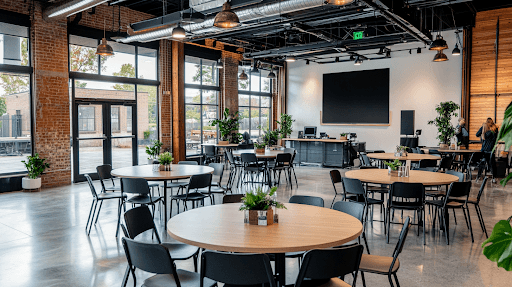Tracking the right metrics can make or break your event marketing efforts. It’s not just about planning great events but about knowing if they deliver results. Without clear data, you’re left guessing what worked and what didn’t. This article breaks down the essential KPIs every event marketer should focus on.
New to event marketing? Our article, "Everything You Need to Know About Event Marketing," will help you get started.
What are event marketing KPIs?
Event marketing KPIs are measurable metrics designed to evaluate the success and impact of your event marketing efforts. They serve as a structured framework to assess whether your event has achieved its specific objectives, such as driving attendance, boosting engagement, or generating leads.
These metrics are not arbitrary; they are tied directly to your event’s goals, making them instrumental in gauging performance and areas for improvement.
By tracking KPIs, you can gain insights into critical aspects of your event, such as attendee satisfaction, financial outcomes, and engagement levels. This allows you to make data-driven decisions that optimize current and future events.
Without these metrics, it becomes challenging to effectively measure success or communicate event value to stakeholders.
Why Are KPIs Essential in Event Marketing?
Key Performance Indicators (KPIs) are essential for ensuring that your event marketing strategies are effective and aligned with your goals. They act as measurable benchmarks, allowing you to gauge how well your event is performing in terms of achieving desired outcomes, such as attendee engagement, lead generation, or revenue growth.
Without KPIs, it becomes nearly impossible to determine whether your efforts are working or where adjustments are needed.
Tracking KPIs enables a process of continuous optimization. By analyzing the data, you can identify strengths, such as high engagement during a particular session, and replicate these successes in future events. At the same time, KPIs help you spot areas that need improvement, such as a low registration-to-attendance conversion rate, and make targeted changes. This data-driven approach not only improves the overall quality of your events but also ensures a higher return on investment (ROI) by focusing resources on what works best.
"Event marketing is as much about measuring impact as it is about creating memorable experiences. If you’re not tracking the right KPIs, you’re essentially throwing darts in the dark—hoping something sticks. Data gives you the clarity to turn good events into exceptional ones." Petri Hollmén, CEO of Lyyti
1. Experience Value Score (EVS)
The Experience Value Score (EVS) is a critical metric that quantifies the perceived value attendees derive from your event. Whether your event is live, online, or hybrid, EVS serves as a universal benchmark for evaluating the quality of the experience delivered.
At its core, EVS captures attendee satisfaction by measuring how well your event aligns with their expectations, needs, and overall experience.
EVS can be applied in several ways to suit different event types and goals:
Live Events: For in-person gatherings, EVS focuses on factors like venue quality, networking opportunities, and the relevance of sessions.
Virtual Events: In digital environments, EVS might assess platform usability, content accessibility, audience interaction, and technical reliability.
Hybrid Events: When combining physical and online formats, EVS evaluates how seamlessly the two elements integrate, ensuring a cohesive experience for all attendees.
By tailoring EVS to your event type, you can gain actionable insights into attendee perceptions and identify areas for improvement. It functions as a "North Star" metric, guiding your efforts to ensure your events consistently deliver value and meet audience expectations.
Importance
Provides clear, actionable insights into attendee satisfaction with a single question, minimizing survey fatigue and boosting response rates.
Tracks industry benchmarks, enabling you to compare your event's performance with competitors and identify opportunities for improvement.
Supports continuous improvement through automated feedback mechanisms, ensuring real-time insights and alignment with attendee expectations.
Techniques to Improve Experience Value Score (EVS)
Use Event EVS to evaluate attendee experiences across all event formats and identify areas for consistent improvement.
Rely on Participant EVS to gather personalized feedback, helping you refine your event strategies based on specific attendee needs.
Implement Pulse EVS to capture real-time feedback through QR codes or links, enabling immediate improvements during the event.
Discover how EVS data from over 200,000 responses and 500+ companies is transforming event evaluation. Download the free report, Experience Value Score (EVS) – the only event KPI you’ll ever need, to explore valuable insights and actionable strategies for improving event success.
2. Registrations and Attendance Rate
Registrations and attendance rates are key metrics that help you measure the effectiveness of your event's promotional efforts. By tracking the ratio of registrations to actual attendees, you can assess how well your marketing strategies convert interest into participation.
This data provides valuable insights into whether your messaging resonates with your target audience and if logistical factors, such as timing or location, affect attendance.
Event check-ins clarify attendance figures by capturing the exact number of participants who physically or virtually attended. This step validates the accuracy of your registration data and identifies any discrepancies between expected and actual turnout. Such insights are critical for refining future marketing and planning efforts.
With Lyyti, you can manage event registrations seamlessly. Create brand-aligned registration pages, collect valuable attendee data with custom fields, and track participant status effortlessly. Streamline the process and make your registration page the perfect start to your customer’s journey.
Importance
Reflects the event’s reach and the effectiveness of marketing efforts in driving sign-ups.
Indicates attendee commitment and potential engagement during the event.
Helps identify areas for improvement, such as misaligned expectations or logistical barriers.
Techniques to Improve Registrations and Attendance Rate
Optimize the Registration Page: Ensure the page is visually appealing, mobile-friendly, and easy to navigate. Use a clear call-to-action (CTA) that directs users to sign up quickly. Simplify forms by minimizing required fields to reduce drop-offs during the registration process.
Utilize Email and Social Media Campaigns: Create targeted email sequences to engage potential attendees who have shown interest but haven’t registered yet. On social media, post engaging content like countdowns, speaker highlights, or session previews, and include direct links to the registration page for a seamless process.
Offer Valuable Incentives: Use strategies like early bird discounts to create urgency or provide exclusive content (e.g., access to premium sessions or downloadable resources) as a reward for signing up. Tailor incentives to the preferences of your target audience to maximize their impact.
3. Engagement Metrics
Engagement metrics track how attendees interact with various elements of your event, offering insight into their level of involvement and interest. These metrics are important for understanding your event’s design's effectiveness and ability to captivate and connect with your audience.
Key engagement activities to monitor include:
Session participation: This measures the number of attendees joining specific sessions and the time they spend in each. It highlights which topics resonate most with your audience and helps identify areas for improvement.
Live poll responses: Tracking response rates to live polls during sessions shows how actively attendees are engaging with the content. High participation in polls often indicates strong interest and attentiveness.
Networking activities: Metrics such as the number of messages exchanged, one-on-one meeting requests, or interactions in virtual networking spaces help evaluate the success of your event’s networking opportunities.
By analyzing these engagement metrics, you can assess whether your event delivers value and fosters meaningful interactions that align with your goals.
Importance
Reflects how well your event content captures and holds the audience's attention.
Helps identify elements of the event that resonate with attendees and areas needing improvement.
Highlights highly engaged participants, providing opportunities for targeted post-event outreach.
Techniques to Improve Engagement Metrics
Incorporate Interactive Elements: Add features like live Q&A sessions, polls, and gamification. These tools encourage active participation, such as asking questions during sessions or engaging in competitive activities like scavenger hunts. This creates a more dynamic and engaging experience for attendees.
Utilize Event Apps or Platforms: Use mobile apps or event platforms to enhance attendee experiences and streamline event management. With tools like chat rooms, personalized agendas, and live session ratings, attendees can easily connect with content and each other. Lyyti’s event check-in app takes this further by enabling effortless check-ins using QR codes, tracking participant status in real-time, adding on-site attendees, and sending personalized SMS messages. These features ensure smooth event operations while improving attendee satisfaction.
Tailor Content to Audience Preferences: Conduct pre-event surveys to understand attendee interests and design sessions or activities accordingly. For example, prioritize hands-on workshops if data shows a preference for interactive learning. Tailored content increases relevance and engagement, leading to a more satisfying experience for participants.
4. Social Media Mentions and Engagement
Social media mentions and engagement metrics track online conversations and interactions about your event. They serve as a window into how your audience perceives and interacts with your brand in the digital space. By monitoring this activity, you can gather critical data points that reflect the event's reach and audience sentiment.
This involves keeping an eye on several key factors:
Mentions: Direct references to your event, often tagged with event-specific hashtags or handles.
Hashtags: The volume and usage of unique hashtags linked to your event.
Shares: The number of times attendees share event-related posts or content.
Engagement: Interactions like likes, comments, and retweets that indicate levels of interest and participation.
These elements help you measure the event’s online visibility and assess how well it resonates with your target audience. Tracking these metrics also provides actionable insights that can shape your future marketing strategies.
Importance
Amplifies your event's visibility through attendee posts, hashtags, and shares, acting as digital word-of-mouth.
Provides real-time insights into attendee sentiment and feedback via comments, reactions, and mentions.
Helps identify areas of success and opportunities for improvement, ensuring better event experiences.
Techniques to Improve Social Media Mentions and Engagement
Create and Promote Event-Specific Hashtags: Develop a unique, memorable hashtag and include it in all pre-event communications like emails, registration pages, and social media posts. Encourage attendees to use it when sharing content and display it prominently at the event on screens and materials to boost adoption and make tracking easier.
Share Live Updates and Behind-the-Scenes Content: Post real-time updates such as photos, videos, and attendee reactions during the event. Include behind-the-scenes content like preparation highlights or team shoutouts to add a personal touch. This keeps attendees engaged and piques the interest of online followers.
Encourage Attendees to Post and Tag the Event: Set up photo-op stations, run social media challenges, or hold contests that reward creative posts. Incentivize attendees to tag your event’s official account and use your hashtag, turning them into advocates and amplifying the event’s reach organically.
5. Net Promoter Score (NPS)
Net Promoter Score (NPS) is a widely used metric in event marketing to measure attendee satisfaction and loyalty. It does this by asking a simple still powerful question: “How likely are you to recommend this event to others?” Respondents provide a score on a scale from 0 to 10, which categorizes them into three groups. Promoters (scores of 9-10) are enthusiastic attendees likely to recommend the event. Passives (scores of 7-8) are satisfied but less likely to actively promote it. Detractors (scores of 0-6) might have had a negative or neutral experience.
To calculate NPS, subtract the percentage of detractors from the percentage of promoters. The result is between -100 and 100, with higher scores indicating stronger attendee satisfaction and loyalty.
This score provides actionable insights into how well your event resonated with its audience and whether improvements are needed to improve their experience.
Importance
Measures attendee loyalty and likelihood to recommend your event, reflecting positive experiences and long-term impact.
Identifies specific pain points through feedback from detractors, highlighting areas for improvement.
Drives repeat attendance and word-of-mouth promotion, amplifying event marketing success.
Techniques to Improve Net Promoter Score (NPS)
Address Pain Points from Previous Events: Use post-event feedback to identify recurring attendee frustrations, such as delays or content issues. Implement targeted solutions, like faster check-in processes or enhanced session quality, to improve the attendee experience.
Provide Exceptional Customer Service and Streamlined Experiences: Ensure smooth touchpoints, from registration to post-event follow-ups. For virtual events, simplify navigation and provide accessible support. For in-person events, focus on amenities like efficient crowd management, clear signage, and thoughtful extras like refreshments to elevate attendee satisfaction.
Follow Up with Detractors to Resolve Issues: Personally engage dissatisfied attendees through emails or calls to understand and address their concerns. Use their feedback to improve future events and demonstrate a commitment to continuous improvement, potentially converting detractors into promoters.
6. Lead Generation and Conversion Rates
Lead Generation and Conversion Rates are essential metrics in event marketing, as they directly measure an event's ability to attract potential customers and convert them into actionable business outcomes. Capturing leads during an event involves gathering contact details or other relevant information from attendees interested in your offerings.
These leads are often collected through registration forms, booth interactions, or digital touchpoints during virtual events.
Conversely, conversion rates indicate how effectively those leads transition into customers, sales, or other desired outcomes. This metric provides valuable insight into the quality of the leads generated and the effectiveness of your post-event follow-up efforts. These metrics help quantify the event's impact on your overall business goals.
Importance
Measures how effectively your event attracts potential customers and drives business outcomes.
Identifies high-quality leads, enabling targeted follow-ups to improve efficiency and reduce wasted effort.
Validates the event’s role in fostering business growth and generating measurable ROI.
Techniques to Improve Lead Generation and Conversion Rates
Use Lead Capture Tools for Streamlined Data Collection: Utilize QR codes, embedded forms, or booth activations to simplify data collection. QR codes can direct attendees to sign-up pages instantly, while interactive booth experiences encourage voluntary data sharing.
Offer High-Value Content or Giveaways: Provide incentives like whitepapers, free trials, or exclusive discounts in exchange for attendee details. For physical events, use branded merchandise; for virtual events, offer downloadable guides or premium session access.
Align Sales and Marketing Teams for Effective Lead Nurturing: Collaborate to segment leads based on interest levels and ensure personalized follow-ups. Sales teams can focus on high-value prospects, while marketing supports the conversion process with tailored communication.
To make the most of your event KPIs, use the Lyyti event retro template to analyze your results effectively. This template helps you reflect on what worked well and identify areas for improvement, ensuring your future events are even more successful. It’s a simple, structured way to celebrate your wins and focus on growth. Download the template now and start creating impactful events with ease!
Conclusion
Tracking event marketing KPIs is an essential practice for measuring success and a strategic tool for continuous improvement. Using these metrics provides clarity, aligns efforts with goals, and ensures every event delivers measurable value.
Marketers can fine-tune their strategies by focusing on key indicators and drive better outcomes with each initiative. Every event is an opportunity to learn, refine, and achieve greater results.
Lyyti is a powerful event management software designed to streamline your event processes and drive measurable success. With tools tailored to track and optimize event marketing KPIs, Lyyti empowers businesses to create impactful live, virtual, and hybrid events.
From seamless registrations to advanced analytics, its features help you understand your audience, improve engagement, and maximize ROI. Ready to transform the way you manage events? Book a demo today and discover how Lyyti can elevate your event strategy.
FAQ
What are the 5 C's of Event Marketing?
The 5 C’s are Concept (event theme/goals), Coordination (seamless planning), Content (engaging material), Communication (effective promotion), and Conversion (measuring outcomes like registrations or sales).
What is a KPI for Events?
A KPI is a measurable metric to track event success, like EVS, attendance rates, lead generation, engagement, social media reach, or ROI.
How Do You Measure Event Marketing Success?
Track KPIs like EVS, attendance, engagement, social media reach, lead generation, ROI, and analyze metrics like ticket sales, feedback, and conversions.
What is the KPI for Marketing?
Marketing KPIs include registrations, attendance rates, engagement metrics (e.g., social media mentions), lead generation, conversion rates, ROI, and customer satisfaction.
Which Event Marketing KPIs Should I Track for Virtual Events?
Track registration/attendance rates, session duration, engagement (polls, chats), lead generation, ROI, and post-event surveys for insights.
Similar articles

Event Analytics Tools: Key Features for Measuring Event Success

Corporate Event Planning: Key Elements for a Successful Event

Event Survey Software: Key Features for Effective Feedback Collection

Event Planning Tips: Strategies for Smooth and Successful Events




